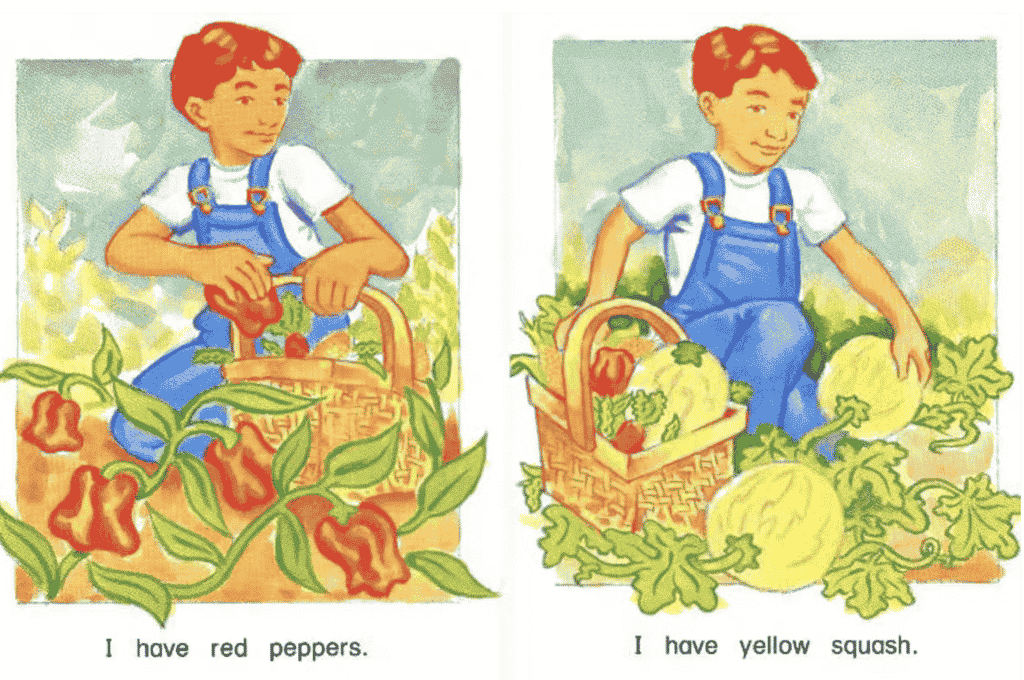Decodable reading books are an essential component of an evidence-based SSP approach and all students, regardless of age, who are in the early stages of reading (typically PLD Stages 1 & 2) should be assigned them.
Decodable reading books only contain phonic concepts and High Frequency Words (HFWs) that students have been explicitly taught. Specifically designed for early readers, they are a means by which students can apply their developing:
- alphabet sound knowledge,
- phonic knowledge,
- phonemic blending, and
- decoding skills.

Decodable books are progressive; as the student learns more phonic concepts and HFWs, the more sophisticated the books become.
In the example on the left, students assigned this book have only been taught Group 1 and 2 Alphabet Sounds (s,a,t,p,i,n & c,h,e,m,d,r) so the assigned books only contain words using these graphemes. Consequently, students can sound-out (blend) the sounds (phonemes) they have been taught, hence decode any word in the book. Along with decoding rehearsal, students will gain confidence in their ability to read.
What Are Whole-Language Reading Books?
The reading books within a whole-language approach to literacy instruction prioritise meaning, but draw heavily on memory, guessing, and prediction strategies (Pogorzelski & Wheldall, 2018). Little to no consideration is given to sound-letter correspondence resulting in meager opportunities for students to apply their emerging decoding skills.
Teaching a student to read using the three-cueing system (look at the first letter, look at the picture, and read on to guess the word) has been discredited by contemporary research as being an inadequate approach to reading instruction.
This is an example of predictive (whole-language) text. Once the first words of the sentence have been decoded, i.e. “I have…” there is no further need to actually read the book due to the repetition of the single sentence starter. The pictures illustrate the colour and type of vegetable located at the end of the sentence, resulting in students guessing (rather than decoding) words.

“Contextual guessing strategies are supported by the cueing systems model of word recognition which has no basis in reading science. According to this theory, students are said to use graphophonic cues, semantic or meaning cues, and syntax or contextual cues to recognize words. In practice, the emphasis is on anything but the links between speech sounds and spelling. Unfortunately, balanced literacy students are learning strategies that poor readers rely on, not what good readers know”
(Moats, L. 2007)
Why Are Decodable Books Important?
As always, PLD’s programs are evidence-based, and the evidence clearly shows that decodable reading books are superior. Decodable books necessitate the utilisation of decoding skills rather than guessing what the words say based on pictures or guessing from other cues.
Who Needs Decodable Reading Material?
It is essential to equip all students who are learning to read with decodable reading material. They are also critical for:
- students in junior primary who are not yet reading fluently, and
- older students in middle and upper primary whose reading is at a junior primary level or who are reading in a dysfluent manner.
Once a student has been explicitly taught the first group of sounds in a SSP sequence and is able to blend, they should be introduced to decodable reading books. If you are a PLD school, this typically transpires in Term 2 of Foundation year. Use the Foundation Early Reading Screen to assign the appropriate range of titles to each student and to track reading progress.
For older students still working at a Stage 1 or Stage 2 level, or for students who need extra practise and develop fluency, please see this article for strategies: PLD’s Catch-up Decodable Reading Books.
Australian Curriculum and Decodable Texts
Since 2015, decodable texts have been included in the Foundation and Year 1 content descriptions, likely as a response to the compelling evidence surrounding their efficacy. This study conducted in WA investigates the use of texts in supporting beginning readers and includes a positive stance on decodable texts.
Likewise, the NSW government is such a strong supporter of decodable texts that they have invested in decodable reading books for all NSW Foundation year classrooms. Read the full statement here.
Where to Get Decodable Reading Books
PLD has sourced a range of fiction and nonfiction decodable texts which largely align with the PLD phonic sequence. Each decodable reading book can be previewed on the PLD website by clicking on the “Preview Book” button underneath the product cover image.
Using Different Types of Books in the Classroom
Decodable books do not replace children’s literature and they are not the only type of texts that should be included in beginning-reader programs. “Teachers and parents should read high-quality children’s literature that contains more complex vocabulary and sentence structures with students every day. This gives children the opportunity to hear good reading models, as well as develop the vocabulary and syntax that will support their reading development” (Five From Five, 2021). For high-quality children’s literature that can be harnessed to develop comprehension skills, take a look at the teacher-friendly Comprehension Questions for three to nine-year-olds.
Further Reading
- How do PLD’s Decodable Reading Books function within the PLD process?
- How do Decodable Reading Books differ from ‘Whole Language’ reading books?
- Which is more effective Repeated Reading or Continuous Reading for improving Reading Fluency?
- Decodable Readers Boost Early Reading
References
- Five From Five. (2021). Decodable books – what are decodable books and why are they important. Retrieved February 2022 @ URL: https://fivefromfive.com.au/decodable-readers/
- Pogorzelski, S., & Wheldall, R. (2018). Explainer: what’s the difference between decodable and predictable books, and when should they be used? Retrieved February 2022 @ URL: https://theconversation.com/explainer-whats-the-difference-between-decodable-and-predictable-books-and-when-should-they-be-used-106531



 print
print